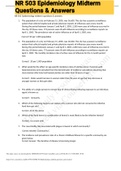Package deal
Chem 210 Questions with Complete Answers Exam Bundle
Chem 210 Questions with Complete Answers Exam Bundle
[Show more]Chem 210 Questions with Complete Answers Exam Bundle
[Show more]What is ground state electron configuration of Co? [Ar]3d^9 [Ar]4s^1 3d^8 [Ar]4s^2 3d^7 [Ar]4s^2 4p^6 4d^1 - [Ar]4s^2 3d^7 molybdenum has an anomalous electron configuration. using the shorthand notation for electron configurations, write the electron configuration A) [kr]5s 4d^6 B) [kr...
Preview 2 out of 14 pages
Add to cartWhat is ground state electron configuration of Co? [Ar]3d^9 [Ar]4s^1 3d^8 [Ar]4s^2 3d^7 [Ar]4s^2 4p^6 4d^1 - [Ar]4s^2 3d^7 molybdenum has an anomalous electron configuration. using the shorthand notation for electron configurations, write the electron configuration A) [kr]5s 4d^6 B) [kr...
Calculate volume 0.2 NaOH and # equivalence points for titration of 25mL 0.1 H3PO4 - 2 eq points- 0.1M x 0.025L = 0.0025 mol H3PO4 mol H3PO4 = mol added NaOH 0.0025 mol NaOH / 0.2 M = 0.0125 L NaOH added Calculate equivalence point volumes for titration of 25.00 mL of 0.060 M HCl and 0.10 M...
Preview 1 out of 4 pages
Add to cartCalculate volume 0.2 NaOH and # equivalence points for titration of 25mL 0.1 H3PO4 - 2 eq points- 0.1M x 0.025L = 0.0025 mol H3PO4 mol H3PO4 = mol added NaOH 0.0025 mol NaOH / 0.2 M = 0.0125 L NaOH added Calculate equivalence point volumes for titration of 25.00 mL of 0.060 M HCl and 0.10 M...
If the fuel efficiency of an automobile is 22 miles per gallon, what is its fuel efficiency in Kilometers per liter? ( 1Km= 0.621 mile, 1.00 L=1.057 quarts and 4 quarts = 1 gallon) - 9.4 Km/L *What is the correct answer to the following expression: (49.1 - 42.61 ) x 13.1? - 85 An intens...
Preview 2 out of 10 pages
Add to cartIf the fuel efficiency of an automobile is 22 miles per gallon, what is its fuel efficiency in Kilometers per liter? ( 1Km= 0.621 mile, 1.00 L=1.057 quarts and 4 quarts = 1 gallon) - 9.4 Km/L *What is the correct answer to the following expression: (49.1 - 42.61 ) x 13.1? - 85 An intens...
What are the differences between aliphatic (including alkanes, alkenes,alkynes and cyclic compounds) aromatic hydrocarbons are. - ALIPHATIC Hydrocarbon: Non-aromatic -Alkanes & CycloAlkanes:single bonds; saturated:Contain only carbon and hydrogen & C-C & C-H single bonds -Alkenes:double bond(s)...
Preview 3 out of 18 pages
Add to cartWhat are the differences between aliphatic (including alkanes, alkenes,alkynes and cyclic compounds) aromatic hydrocarbons are. - ALIPHATIC Hydrocarbon: Non-aromatic -Alkanes & CycloAlkanes:single bonds; saturated:Contain only carbon and hydrogen & C-C & C-H single bonds -Alkenes:double bond(s)...
if the p-value is greater than 0.1, we generally conclude the data are consistent with the null hypothesis - true what is the best way to characterize the random error present in a measurement? - take replicate measurements of your analytes and using the standard deviation and a t-table spe...
Preview 2 out of 7 pages
Add to cartif the p-value is greater than 0.1, we generally conclude the data are consistent with the null hypothesis - true what is the best way to characterize the random error present in a measurement? - take replicate measurements of your analytes and using the standard deviation and a t-table spe...
E2 Reaction - One-Step with no intermediates, Base takes off proton + LG leaves with double bond formation. What type of carbons do E2 rxns favor? - Tertiary What is a Zaitsev product? - Double bond formation on more substituted carbon What is a Hoffman product? - Double bond fo...
Preview 1 out of 3 pages
Add to cartE2 Reaction - One-Step with no intermediates, Base takes off proton + LG leaves with double bond formation. What type of carbons do E2 rxns favor? - Tertiary What is a Zaitsev product? - Double bond formation on more substituted carbon What is a Hoffman product? - Double bond fo...
C The electron configuration of indium, In, is ______. B In general, atomic radii _____. A) increase from left to right in a period and increase down a group. B) decrease from left to right in a period and increase down a group. C) increase from left to right in a period and decrease down...
Preview 4 out of 32 pages
Add to cartC The electron configuration of indium, In, is ______. B In general, atomic radii _____. A) increase from left to right in a period and increase down a group. B) decrease from left to right in a period and increase down a group. C) increase from left to right in a period and decrease down...
Cation vs Anion - Cation- positive charge Anion- negative charge Electromagnetic Spectrum - (Short λ) Gamma, Xray, Ultra Violet, Visible, Infrared, Micro, Radio (Long λ) Frequency vs Wavelength - Long Wavelength (λ)→Low Frequency (v) Short Wavelength (λ)→High Frequency (...
Preview 2 out of 7 pages
Add to cartCation vs Anion - Cation- positive charge Anion- negative charge Electromagnetic Spectrum - (Short λ) Gamma, Xray, Ultra Violet, Visible, Infrared, Micro, Radio (Long λ) Frequency vs Wavelength - Long Wavelength (λ)→Low Frequency (v) Short Wavelength (λ)→High Frequency (...
enantiomers are formed from __________ carbocation - achiral __________ are formed from chiral carbocation - enantiomers grignard reagents attack (most/least?) substituted epoxide? - least grignard reagents are used for (carbanion/carbocation?) generation. - carbanion we wat ...
Preview 1 out of 4 pages
Add to cartenantiomers are formed from __________ carbocation - achiral __________ are formed from chiral carbocation - enantiomers grignard reagents attack (most/least?) substituted epoxide? - least grignard reagents are used for (carbanion/carbocation?) generation. - carbanion we wat ...
Question 1 3 / 3 pts True or False: Nitrogen is called the superglue of the chemical world. FALSE True or False: Large elements, such as strontium, are common in biomolecules. FALSE True or False: The time it takes for a compound to flow through a metabolic pathway is called the payo...
Preview 3 out of 19 pages
Add to cartQuestion 1 3 / 3 pts True or False: Nitrogen is called the superglue of the chemical world. FALSE True or False: Large elements, such as strontium, are common in biomolecules. FALSE True or False: The time it takes for a compound to flow through a metabolic pathway is called the payo...
what factors explain the outcomes of reactions? - hybridization, delocalization, eN, atom density what is a leaving group? - - group of atom(s) that can be stable on its own - eN atoms that are good LG also make strong acids what is the α carbon? - C directly attached to leaving gro...
Preview 2 out of 9 pages
Add to cartwhat factors explain the outcomes of reactions? - hybridization, delocalization, eN, atom density what is a leaving group? - - group of atom(s) that can be stable on its own - eN atoms that are good LG also make strong acids what is the α carbon? - C directly attached to leaving gro...
How does Volume Decrease Affect Equilibrium? - Equilibrium will shift toward the side with the fewest gas molecules. How does Volume Increase affect Equilibrium? - Equilibrium will shift the reaction left How will an increase in temperature affect the equilibrium of a solution with a -de...
Preview 1 out of 3 pages
Add to cartHow does Volume Decrease Affect Equilibrium? - Equilibrium will shift toward the side with the fewest gas molecules. How does Volume Increase affect Equilibrium? - Equilibrium will shift the reaction left How will an increase in temperature affect the equilibrium of a solution with a -de...
less - the more s character a carbocation has, the _____stable it is the same as - when looking at an epoxide, the orientation around the oxygen is _________ the orientation around the double bond in the reactant BrOH - when added with base makes an epoxide Br2 - adds 2 Brs in a...
Preview 1 out of 4 pages
Add to cartless - the more s character a carbocation has, the _____stable it is the same as - when looking at an epoxide, the orientation around the oxygen is _________ the orientation around the double bond in the reactant BrOH - when added with base makes an epoxide Br2 - adds 2 Brs in a...
electrophiles - electron seeking reagents that have room to accept a electron pair nucleophiles - reagents seeking a nucleus to which to donate a pair of electrons proton transfer or protonation reaction - the transfer of a proton from one base to another transition state - lyin...
Preview 2 out of 5 pages
Add to cartelectrophiles - electron seeking reagents that have room to accept a electron pair nucleophiles - reagents seeking a nucleus to which to donate a pair of electrons proton transfer or protonation reaction - the transfer of a proton from one base to another transition state - lyin...
Anode = what? - oxidation Cathode = what? - Reduction A Oxidizing agent ? - •takes electrons from the substance being oxidized. • The oxidizing agent itself is reduced: Cu 2+ -> Cu (s) A reduction agent ? - • gives electrons to the substance being reduced. • The r...
Preview 1 out of 4 pages
Add to cartAnode = what? - oxidation Cathode = what? - Reduction A Oxidizing agent ? - •takes electrons from the substance being oxidized. • The oxidizing agent itself is reduced: Cu 2+ -> Cu (s) A reduction agent ? - • gives electrons to the substance being reduced. • The r...
Primary carbon with weak base (CN-) - SN2 Primary carbon with moderate base (CCH-) - SN2 Secondary carbon with weak base (CN-) - SN2 Secondary carbon with moderate base (CCH-) - E2 Tertiary carbons can go thru... - E2, E1, and SN1 Very weak bases can only force a reacti...
Preview 1 out of 3 pages
Add to cartPrimary carbon with weak base (CN-) - SN2 Primary carbon with moderate base (CCH-) - SN2 Secondary carbon with weak base (CN-) - SN2 Secondary carbon with moderate base (CCH-) - E2 Tertiary carbons can go thru... - E2, E1, and SN1 Very weak bases can only force a reacti...

Stuvia customers have reviewed more than 700,000 summaries. This how you know that you are buying the best documents.

You can quickly pay through EFT, credit card or Stuvia-credit for the summaries. There is no membership needed.

Your fellow students write the study notes themselves, which is why the documents are always reliable and up-to-date. This ensures you quickly get to the core!
You get a PDF, available immediately after your purchase. The purchased document is accessible anytime, anywhere and indefinitely through your profile.
Our satisfaction guarantee ensures that you always find a study document that suits you well. You fill out a form, and our customer service team takes care of the rest.
Stuvia is a marketplace, so you are not buying this document from us, but from seller TeeGrades. Stuvia facilitates payment to the seller.
No, you only buy this summary for R756,96. You're not tied to anything after your purchase.
4.6 stars on Google & Trustpilot (+1000 reviews)
64670 documents were sold in the last 30 days
Founded in 2010, the go-to place to buy summaries for 15 years now








